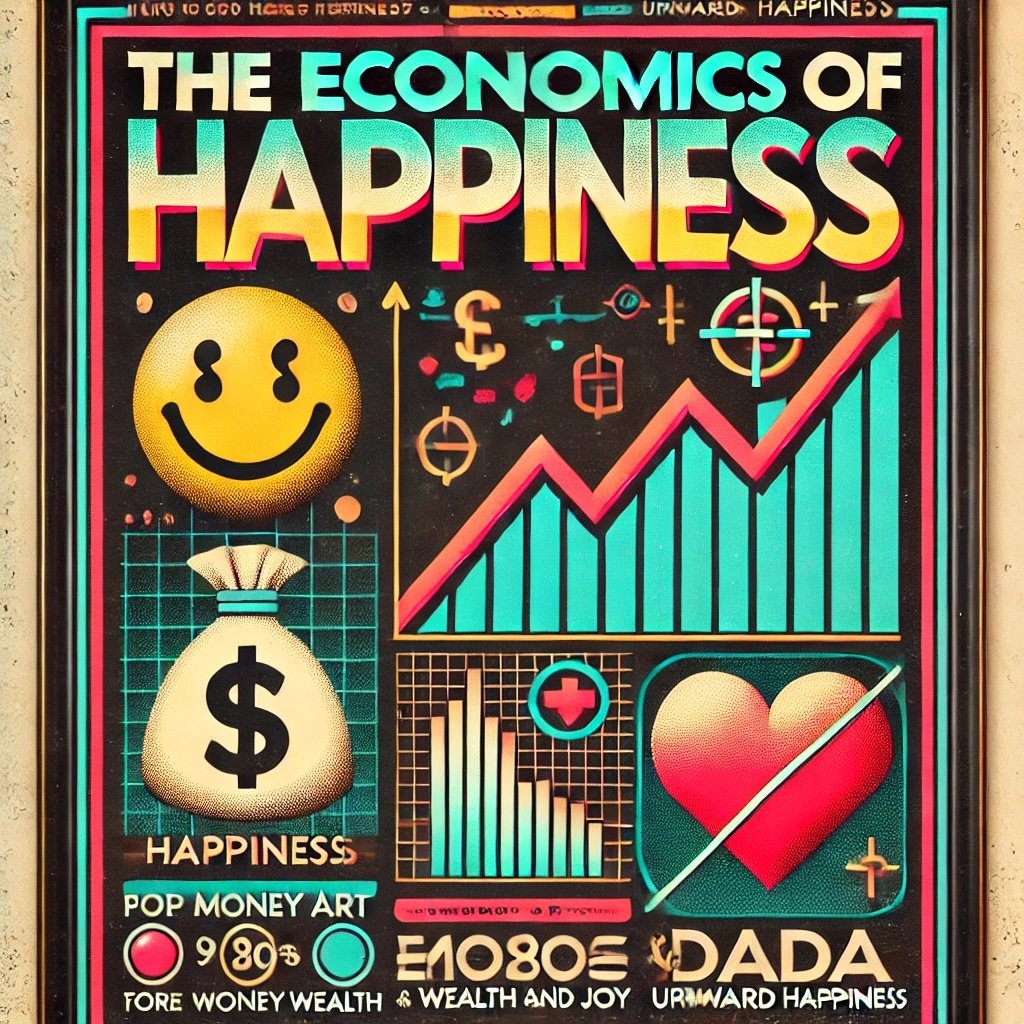Warren Buffett stands out as one of the most admired figures in the realm of finance. His name often evokes images of consistent market outperformance, billions of dollars in net worth, and a calm demeanor that seems impervious to the frenetic nature of modern investing. Beyond these surface impressions, however, lies another dimension—one that deals more with the mind than with money. Buffett’s success stems not only from his technical competence in valuation or his mastery of compound interest, but also from a set of psychological attributes that shape his decision-making process on a deeper, more personal level.
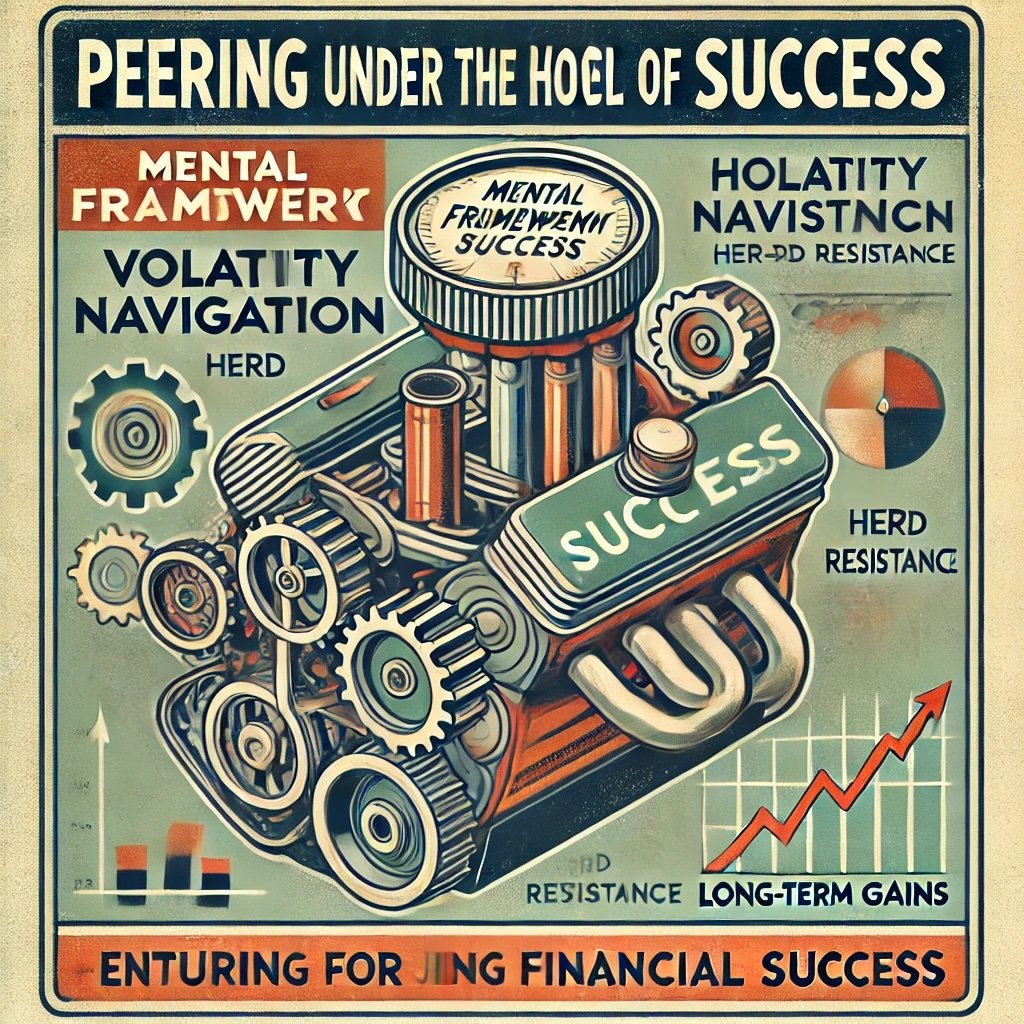
Understanding these psychological traits is akin to peering under the hood of a high-performance vehicle. Yes, the engine’s horsepower (in investing terms, capital and returns) matters, but what’s equally vital is the design of the engine itself—how its components align to produce sustained power and efficiency. Similarly, Buffett’s enduring success does not happen by chance or mere luck. It’s the result of a methodical, introspective approach that helps him navigate volatility, resist herd mentality, and remain steadfast in the pursuit of long-term gains.
What are these traits, exactly? They include emotional discipline—his knack for staying even-keeled under pressure; patience—his readiness to wait for the right opportunity rather than chase every fleeting possibility; humility—his openness to learning and admitting mistakes; rationality—his reliance on logic and data over hype; continuous learning—a lifelong devotion to reading, self-education, and iterative growth; and finally, a long-term vision that allows him to filter out daily noise in favor of multi-decade objectives. Taken together, these qualities form a mental toolkit that shields him from the pitfalls that ensnare countless other investors, from emotional overreactions to inflated egos or panic-driven trades.
![]()
Such traits are not simply the domain of the ultra-wealthy or the famously savvy. They’re accessible to anyone willing to work on them. For instance, you don’t need billions in the bank to cultivate emotional discipline or patience. Nor do you require an Ivy League degree to approach problems with calm rationality or to build a reading habit that fosters continuous learning. Buffett’s mental frameworks can serve as a universal guide, one that extends beyond trading floors and into realms like career development, personal relationships, and everyday problem-solving.
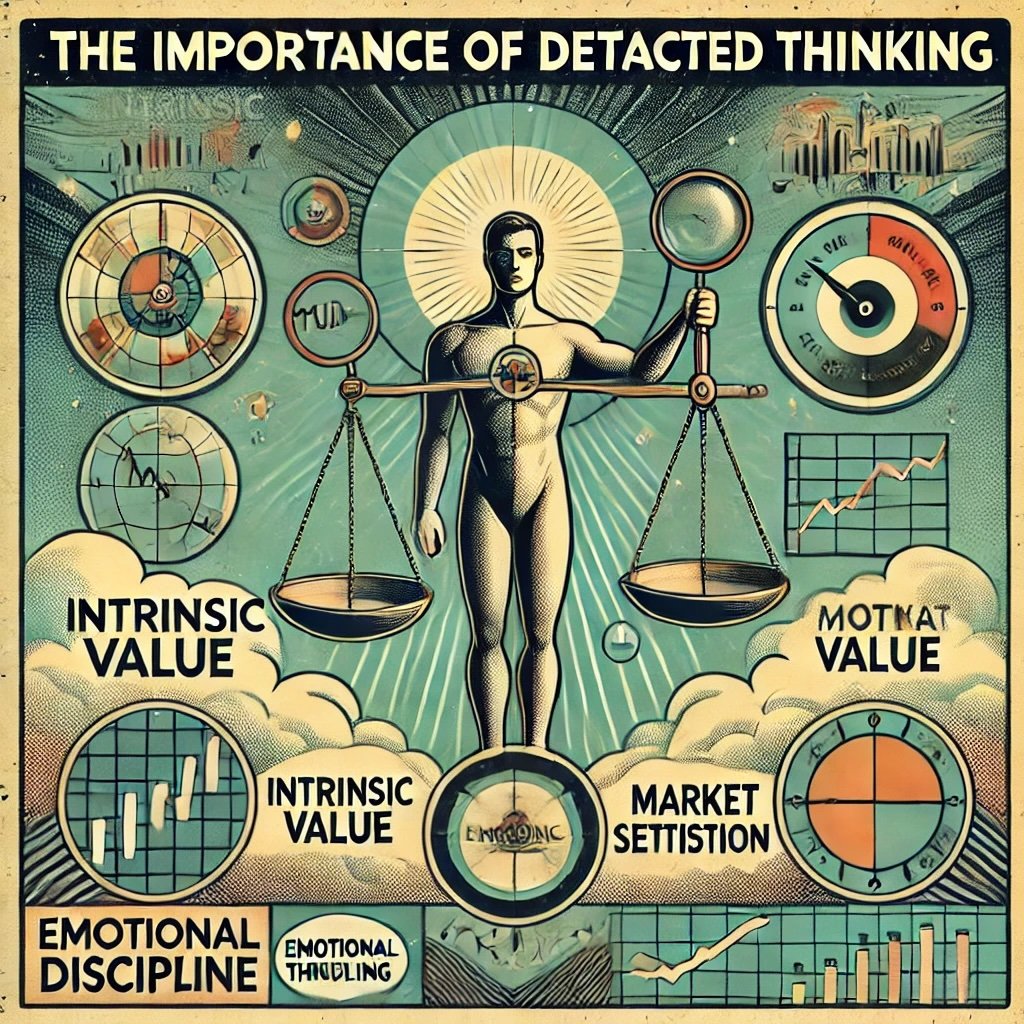
Emotional Discipline: Staying Calm Under Pressure
Resisting Emotional Reactions
At the heart of Warren Buffett’s remarkable success is his uncanny ability to keep his emotions in check—even when the financial world appears to be in free fall. This isn’t a trivial skill. Many investors have seen substantial portions of their portfolios vanish because they let fear, greed, or euphoria drive critical decisions. Buffett, by contrast, has crafted a persona—whether consciously or not—of the unflappable patriarch who observes market gyrations with serene detachment.
When stock prices collapse, he doesn’t scramble for the exits. Rather, he quietly studies the situation, assessing whether the dips are mere emotional reactions or reflections of a company’s genuine troubles. In bull markets, where speculation can drive valuations to irrational heights, he refuses to jump on the bandwagon just because everyone else is. This temperament allows him to buy undervalued assets when others are panic-selling, and sidestep overvalued darlings at the peak of mania. The net effect is a strategy that often outperforms over time, not by huge leaps every year, but through steady, rational moves that accumulate over decades.
The Importance of Detached Thinking
Buffett’s stoicism is not about being apathetic; it’s about deploying a certain detachment that fosters clear thinking. He’s famously quoted as saying that if you cannot manage your emotions, you can’t manage money. This principle resonates in myriad decisions he’s made, from refusing to invest in dot-com startups during the tech bubble to holding onto high-quality stocks during the 2008 financial crisis, even as markets plunged. A purely data-driven mindset, stripped of panic, enables him to evaluate opportunities based on intrinsic business fundamentals rather than short-term market sentiment.
He’s also mindful of the emotional climate around him. If the investment community is frothing at the mouth over a particular sector, Buffett grows wary. If every news outlet declares that capitalism as we know it is ending, he might see it as an invitation to go bargain hunting. This contrarian approach is possible only through emotional discipline, steering him away from knee-jerk responses.
Managing Greed and Fear
Fear and greed are commonly cited as the two most potent emotions in the stock market, and Buffett has a handle on both. He doesn’t let greed blind him to inflated valuations. Nor does he let fear paralyze him when bargains present themselves. In one of his most famous lines, he advises to “be fearful when others are greedy and greedy when others are fearful.” This simple yet profound statement underscores his entire approach: emotional extremes in the market create pricing inefficiencies, and by maintaining composure, an investor can systematically exploit them.
Practical Lessons for Readers
So how can average individuals channel Buffett’s emotional discipline in their own finances?
- Identify Your Triggers: Notice when you feel compelled to make a hasty financial decision—like selling at the first sign of bad news. Reflect on whether it’s based on actual changes in the company’s fundamentals or just an emotional reaction to negative headlines.
- Set Rules in Advance: Buffett’s discipline often comes from having predefined thresholds and guidelines. For instance, you might decide you’ll only sell a stock if it drops below a specific price because of clear, fundamental deterioration, not merely because the market is diving.
- Slow Down: In periods of market volatility, take a 24-hour pause before executing trades. This cooling-off period can prevent impulsive moves driven by panic or excitement.
- Seek Objective Data: Lean on facts—balance sheets, earnings reports, or credible analysis—over sentiment-based media coverage or rumor mills. Buffett’s decisions hinge on tangible evidence, not ephemeral hype.
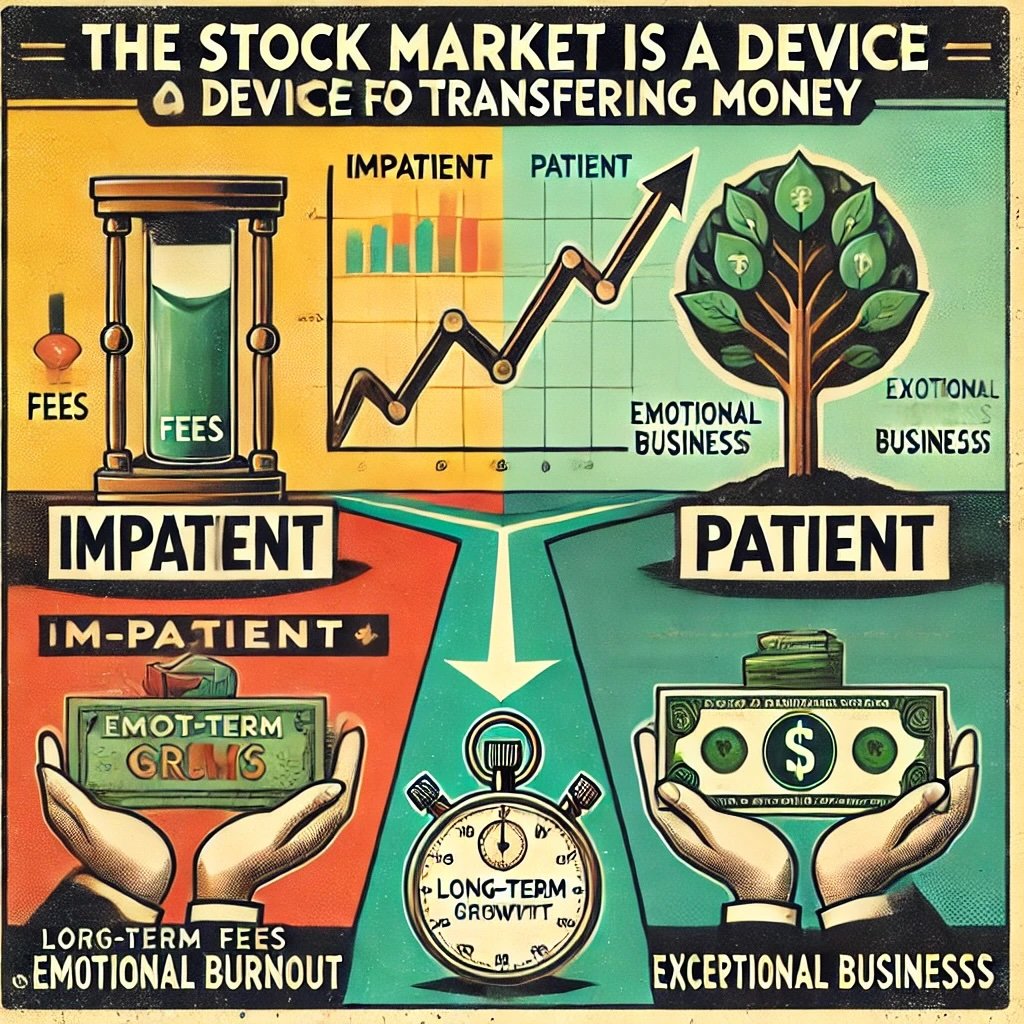
Patience: The Art of Waiting for the Right Opportunity
“The Stock Market Is a Device for Transferring Money”
Buffett has often described the stock market as a mechanism that transfers money “from the impatient to the patient.” That phrase neatly captures his belief that true wealth creation isn’t about frenetic trading or instantaneous payoffs; it’s about identifying exceptional businesses and holding onto them for an extended duration. This mindset fosters a stark contrast to many investors, who might flip stocks daily, weekly, or even monthly in pursuit of immediate gains. Buffett warns that such short-termism can be perilous, leading to excessive fees, emotional burnout, and suboptimal performance. Instead, he invests as though he’s buying entire companies, not just ticker symbols.
Letting Compounding Work Its Magic
One of the greatest forces in finance is compound interest, and Buffett has harnessed it to spectacular effect. By committing to a select group of high-quality stocks and allowing compounding to accumulate returns year after year, he transforms modest annual growth into staggering long-term wealth. This synergy occurs only if you refrain from constantly reshuffling your portfolio in response to market chatter or minor dips.
Compounding also flourishes when reinvesting dividends. If you find a stable, dividend-paying company, re-plowing those payouts into additional shares can exponentially expand your holdings. But again, this is less about picking the perfect stock every quarter and more about steadily riding the wave of compounding over many years. If you keep jumping in and out, you break the compounding cycle, forfeiting the full potential of exponential gains.
Avoiding the Noise
Patience requires filtering out the “noise.” Markets generate a constant roar of updates, from bullish analysts touting rapid growth to doomsayers predicting imminent crashes. Buffett is notoriously indifferent to short-term market predictions. He rarely tries to time macroeconomic cycles. Instead, he focuses on the enduring fundamentals of each business—earnings power, competitive advantage, and management quality. If these elements remain robust, day-to-day or month-to-month fluctuations carry little weight.
For everyday investors, this stance can manifest as a vow to check your portfolio infrequently—maybe monthly or quarterly, rather than every hour. It might also mean ignoring sensational headlines screaming about record highs or catastrophic lows. By stepping away from the constant data feed, you cultivate the psychological space to remain patient.
The Art of Waiting for the Right Opportunity
Patience also underpins Buffett’s notion of the “20-slot punch card,” wherein he suggests you pretend you only have 20 investment decisions over your entire life. This constraint forces you to be exceedingly choosy, waiting for a truly outstanding chance rather than scattering money across every fleeting opportunity. Because if you have to get it right, you’ll make sure you deeply understand the company, the valuation, and the potential risks.
In practical terms, you might interpret this as building a watchlist of companies you admire but only moving in when their share prices dip to levels that match your valuation models. Or, if you’re not comfortable with stock picking, you might patiently dollar-cost average into an index fund, ignoring short-term price variations. Either way, you deploy patience as a buffer against impulsive trading.

Humility: Acknowledging Mistakes and Limits
Learning from Errors
Warren Buffett stands among history’s most successful investors, yet he’s also remarkably candid about his failures. Throughout his annual letters to Berkshire Hathaway shareholders, he periodically points to ill-timed acquisitions or missed opportunities, offering an analysis of what went wrong. These admissions aren’t superficial; they reflect a sincere effort to dissect errors and glean insights for future decisions. In a high-stakes arena like investing—where an image of infallibility can become an ego trap—Buffett’s willingness to admit he doesn’t always get it right keeps him nimble. This humility fosters a culture of continuous improvement, not just for him personally, but also for the managers and subsidiaries under Berkshire’s umbrella.
Why does acknowledging mistakes matter so much? First, it forces you to confront the realities of your process, shining a light on overlooked variables or flawed assumptions. Second, it tempers overconfidence. Investors who view themselves as invincible often disregard caution, over-leveraging or diving into risky sectors. Buffett’s humility acts as a built-in restraint, reminding him to re-examine the data instead of believing his success is guaranteed.
Staying Within the Circle of Competence
The phrase “circle of competence” is central to Buffett’s philosophy. It means sticking to what you know—and knowing where your expertise ends. Buffett invests in companies whose business models he understands, such as insurance, banking, consumer goods, and railroads. When it comes to complicated biotech or cutting-edge tech that he can’t evaluate with confidence, he generally passes. This principle arises not from fear, but from humility: acknowledging that no one can be an expert in every domain.
For everyday investors, the lesson is clear: you don’t need to chase every hot sector or newfangled product. Focus on industries where you can accurately gauge trends and financial performance. If you step outside that boundary, do so only after thorough research and possibly with guidance from more knowledgeable collaborators. The humility embedded in this approach reduces the likelihood of getting blindsided by complexities you never saw coming.
Deflecting Ego
Buffett’s humility also shapes his interactions with peers, subordinates, and the media. He’s known for delivering folksy analogies and plainspoken explanations rather than flaunting arcane financial jargon. This style endears him to a broad audience but also keeps him approachable to employees who might hold differing views. If arrogance pervaded the leadership dynamic at Berkshire Hathaway, managers might hesitate to challenge or refine business strategies, stifling constructive debate.
Additionally, Buffett’s personal lifestyle underscores this humility. He still resides in the same home he purchased decades ago. He doesn’t flaunt private jets for personal use (though Berkshire Hathaway does own NetJets) or wear designer suits. This modesty resonates with shareholders who trust him not to squander company resources on vanity. More importantly, it underscores a mental framework: Buffett’s self-worth doesn’t hinge on luxurious displays. He invests for the joy of the craft and the long-term benefits, not to stoke his ego.
The Benefits of Humility in Investing
Humility in investing fosters open-mindedness. When new data emerges, a humble investor can integrate it without the friction of wounded pride. Buffett demonstrates this by modifying his stance on certain tech companies over time—like Apple—after concluding he’d been too dismissive of their consumer-brand power. Had he clung to pride and insisted he was “too old-school” for tech, he might have missed one of Berkshire’s most profitable positions.
In essence, humility is the glue that holds other psychological traits together. It supports emotional discipline (by mitigating overreaction), patience (by preventing misguided impatience to prove oneself), rationality (by urging fact-based reflection over ego-driven decisions), and continuous learning (since one who thinks they know it all won’t expand their knowledge).
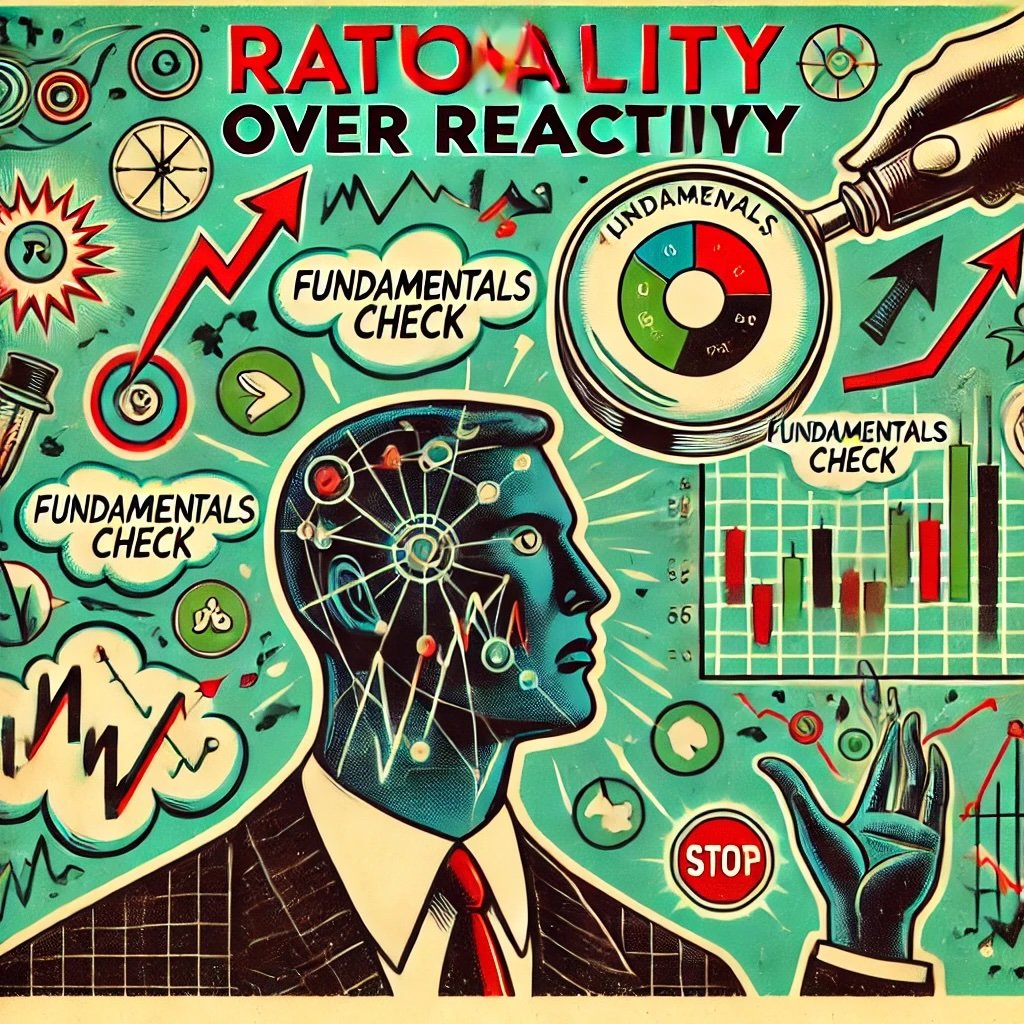
Rationality: Making Decisions Based on Facts, Not Hype
Data-Driven Analysis
Rationality is the bedrock on which Warren Buffett’s investment empire stands. While emotional discipline and humility shield him from psychological pitfalls, it’s rational thinking that propels him toward the correct choices in the first place. He doesn’t rely on tips from internet forums or sensational headlines proclaiming the next big thing. Instead, he dives into company balance sheets, earnings reports, and industry metrics, meticulously discerning whether a firm’s actual worth justifies its current market valuation. This data-centric approach frees him from being swayed by fleeting fads or rumor-driven price swings.
Buffett’s routine is surprisingly simple: he reads. A lot. Annual reports, shareholder letters, economic analyses—each piece of information feeds into a structured mental model. When he finally decides to buy or sell, it’s typically after days (if not weeks) of rational deliberation. For the average investor, this method might manifest as devoting time each weekend to review your holdings’ earnings updates or macroeconomic shifts, rather than reacting impulsively midweek because a stock ticker started flashing red.
Avoiding Herd Mentality
Herd mentality is a formidable force. People often chase the same stocks their friends boast about, or the ones the media touts as “the next big thing,” fearing they’ll miss out. Buffett, however, rarely invests in what’s trendy. He famously refrained from the dot-com bubble, observing from the sidelines as valuations soared on companies with no sustainable revenue. That stance, widely ridiculed at the time, ultimately saved him from disastrous losses when the bubble burst.
To replicate this mindset, you don’t need Buffett’s billions. You just need a framework that requires you to verify a stock’s fundamentals—cash flow, profit margins, competitive advantages—before jumping in. If the only rationale for buying is a glowing news snippet or social media hype, you’re essentially gambling. Buffett’s rational approach demands deeper inquiry: does the company have real products or services that deliver consistent value? Is the management adept and ethical? Are the price-to-earnings ratios or other valuation metrics reasonable compared to industry norms?
Applying Mental Models
Charlie Munger, Buffett’s long-time partner, champions “mental models”—concepts drawn from diverse fields like psychology, engineering, and biology—to analyze situations more holistically. Buffett uses these, too, in evaluating risk-reward balances or in sizing up intangible factors like corporate culture. This layering of interdisciplinary knowledge fosters a robust rational framework, helping Buffett see angles others miss.
For instance, the concept of “inertia” from physics might metaphorically describe how large consumer brands maintain momentum. Or “incentive structures” from psychology might clarify how employee bonuses can distort corporate decision-making. Infusing such mental models into your own investment process can refine your logic and filter out empty hype. If something doesn’t match a known principle or pattern of success, you can discount it more confidently.
Rationality Over Reactivity
The ultimate hallmark of Buffett’s rationality is his ability to pause. Markets might be in meltdown, but he can step back and re-check the math. Are the fundamentals still intact, or is this drop purely emotional? If it’s the latter, that might be a green light to buy. Conversely, if a hot stock soars while ignoring any realistic measure of value, he’s willing to abstain. This ability to detach from the noise and remain faithful to fundamental data is a bulwark against the emotional and psychological chaos of bull-and-bust cycles.
For personal investors, adopting rationality means creating a structured plan for analyzing stocks or funds. Perhaps you maintain a spreadsheet of key metrics or keep a written checklist that each prospective investment must pass. It’s not glamorous, but it’s the essence of Buffett’s formula: remove guesswork, rely on factual evidence, and trust the disciplined process over impulsive whims.

Continuous Learning: The Lifelong Pursuit of Knowledge
Reading as a Daily Habit
When asked about the secret to his success, Warren Buffett sometimes raises a stack of papers and says, “Read 500 pages like this every day. That’s how knowledge works. It builds up, like compound interest.” This single habit—voracious reading—sheds light on why his investment theses are so comprehensive and consistent. Newspapers, corporate annual reports, biographies, economic analyses, scholarly articles—Buffett devours a wide range of materials. He doesn’t cram for a test or read solely for short-term stock picks. Instead, he nurtures an ongoing dialogue with the world, absorbing insights that can pop up in unexpected ways later.
While 500 pages daily might be impractical for most people, the principle stands: the more informed you are, the less you rely on gut feelings or rumors. This knowledge accumulation fortifies your emotional and rational frameworks, as you’re continuously upgrading your understanding of how businesses and economies function. In turn, you become more adept at identifying opportunities and spotting risks, which is crucial when markets shift or new technologies emerge.
Seeking Wisdom from Others
Another dimension of Buffett’s learning approach involves mentorship and collaboration. His partnership with Charlie Munger exemplifies a mutual exchange of ideas. Munger introduced him to the concept of mental models and helped broaden his perspective beyond pure financial metrics to include psychological, sociological, and philosophical insights. In addition, Buffett has been open about how Benjamin Graham’s principles guided his early investment style. Even as he evolved from Graham’s strict value metrics to a more nuanced focus on quality, Buffett never discarded the lessons gleaned from mentors, adopting what worked and refining the rest.
For individual investors, mentorship might manifest through seeking out coaches, joining investment clubs, or engaging with online communities dedicated to thoughtful, data-driven discussions. You can also “mentally” adopt mentors by diving into the works of thought leaders—reading their books, watching their lectures, and dissecting their case studies. Buffett himself gleaned wisdom from historical figures like Benjamin Franklin, soaking up principles of frugality and entrepreneurial thinking.
Adapting to Change
A hallmark of continuous learning is adaptability. Buffett’s investment style evolved considerably from his Graham-inspired “cigar-butt” approach—focusing purely on undervalued metrics—to a philosophy that values durable competitive advantages and brand power. Apple stands as a prime illustration. For years, Buffett avoided tech stocks, citing uncertainty about their future. Over time, as he recognized Apple’s ecosystem strength and consumer brand loyalty, he pivoted. That evolution was not a betrayal of his initial stance but a testament to his readiness to incorporate new information.
In a rapidly changing world, industries rise and fall at unprecedented speeds. Sticking rigidly to old playbooks can leave you behind. Buffett’s willingness to adapt, buttressed by ongoing learning, lets him incorporate emerging market realities without abandoning his foundational principles of rationality and margin of safety.
Building Your Personal Learning System
If you wish to emulate Buffett’s continuous learning, start by curating a reading list aligned with your interests, whether that’s finance, technology, healthcare, or consumer goods. Don’t shy away from cross-disciplinary exploration—economics can blend with psychology, or tech can inform your understanding of consumer behavior. Periodically step back and evaluate what new knowledge you’ve absorbed and how it might influence your investment decisions. You might keep a journal summarizing the key takeaways from each book or article, ensuring the lessons stick and can be retrieved when necessary.
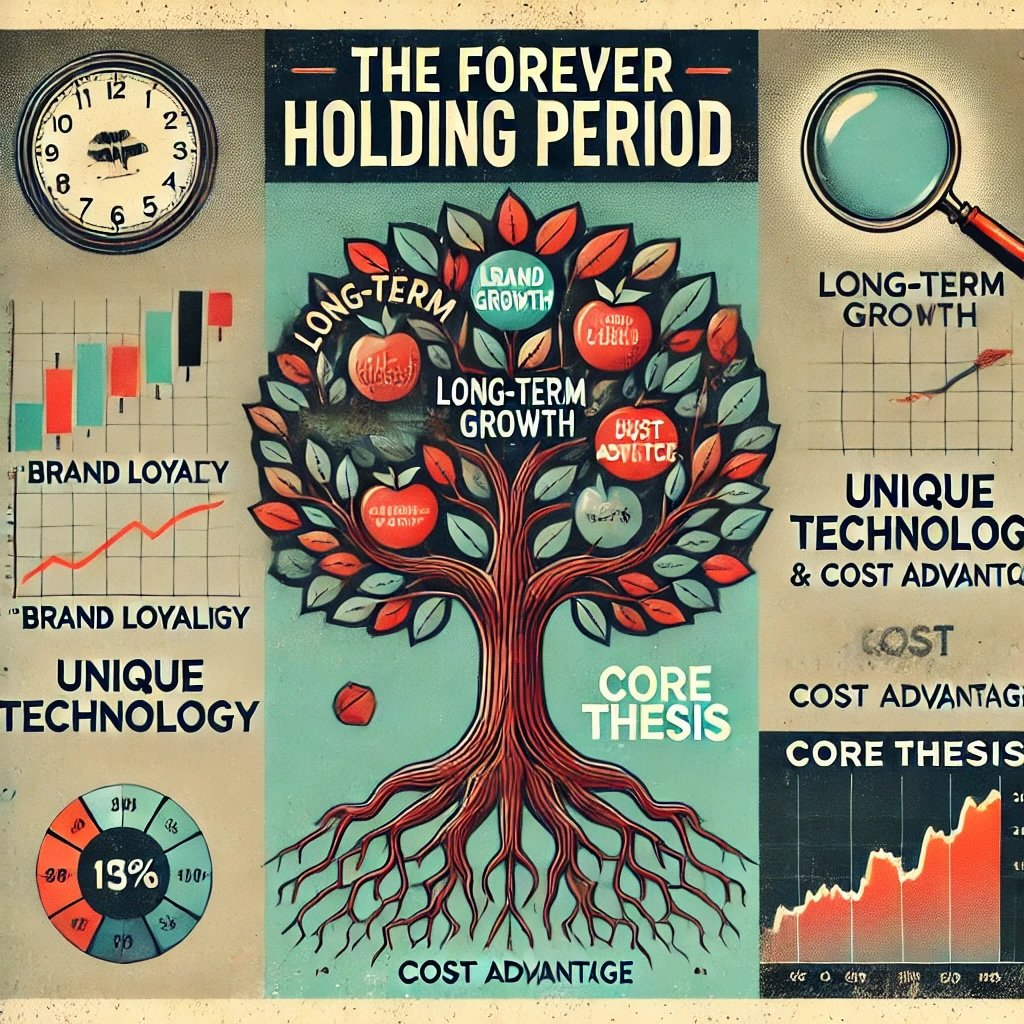
Long-Term Vision: Thinking Decades Ahead
The “Forever” Holding Period
Warren Buffett is renowned for saying, “Our favorite holding period is forever.” While he doesn’t literally keep every stock until the end of time, the quip underscores his commitment to selecting businesses he believes will remain robust well into the future. The idea is straightforward but powerful: if you find a truly great company at a sensible price, hold onto it through market cycles, trusting its inherent strengths to weather short-term volatility. This perspective is the antithesis of day trading or speculation, which focuses on short-term price swings.
For regular investors, adopting a long-term lens means you’re less likely to sell in a panic when headlines turn grim or a quarterly earnings report disappoints. Instead, you evaluate whether the core thesis—like a company’s brand loyalty, unique technology, or cost advantage—still stands. If it does, short-term dips can be an opportunity, not a crisis. That equanimity, deeply psychological in nature, keeps you on course even when others succumb to fear or greed.
Ignoring Short-Term Noise
What does it mean to ignore short-term noise? Buffett epitomizes it by rarely reacting to daily price fluctuations or sensational media coverage. If a business’s fundamentals haven’t changed, he’s unshaken by random sell-offs or ephemeral hype. This patience sets him apart from traders who respond to every rumor or data release, incurring transaction costs and stress.
To emulate Buffett here, you might limit how often you check your portfolio—maybe once a week or even once a month, unless there’s a major development in the companies you own. By doing so, you sidestep the emotional roller coaster that daily updates can provoke. Your energies refocus on analyzing new expansions, product lines, or management shifts that genuinely affect long-term value, rather than ephemeral chatter.
Building Legacy, Not Just Wealth
Buffett’s long-term mindset also extends beyond personal gains. He has pledged to donate the bulk of his fortune to philanthropic causes. This speaks to an overarching vision of stewardship: accumulating capital not merely for status or extravagance, but for meaningful impact. While philanthropic endeavors might not be your immediate concern, the principle remains instructive. If you think about your financial goals in multi-decade terms—whether that’s leaving a nest egg for your children, funding charitable projects, or simply ensuring a comfortable retirement—you ground your decisions in enduring aspirations rather than short-term gratification.
This emphasis on legacy can also deter rash expenditures. You weigh each decision—like buying a luxury car or a bigger house—against its effect on your overarching life plan. Does it align with your long-term objectives, or is it a spur-of-the-moment indulgence that might impede your bigger dreams? Buffett’s frugality reflects this principle. By investing resources in valuable assets and philanthropic commitments, he channels his wealth toward generational impacts.
In Harmony with Other Traits
The long-term vision harmonizes neatly with the psychological traits we’ve already discussed. Emotional discipline ensures you don’t get spooked by short-term dips. Patience allows you to hold for years or decades, letting compounding unfold. Humility reminds you that markets can be unpredictable, so you better anchor in enduring fundamentals. Rational analysis ensures that you focus on business realities over daily noise, while continuous learning keeps you attuned to shifts that might affect your long-term thesis.
Together, these traits make for an investment style that is both robust and peaceful. Buffett doesn’t just build wealth—he builds it with relative serenity, seldom rattled by the day’s headlines. For most of us, adopting even a fraction of this worldview can mitigate a lot of the angst associated with financial decisions. If you trust that a well-chosen stock, index fund, or real estate holding will appreciate over years, you’re less prone to stress about short-run setbacks.
Hence, Buffett’s success story isn’t just about astute stock picks. It’s about the mind behind those picks—the psychological scaffolding that keeps him consistent, curious, and resilient. To emulate even a fraction of his accomplishments, one needs to look inward as much as outward, honing these same attributes in whatever domain you choose to pursue. As Buffett himself has often implied, real wealth—both emotional and financial—stems from harnessing these inward qualities, forging a path that remains steady amid the market’s ever-shifting tides.
The Psychological Traits That Make Warren Buffett Successful: 12-Question FAQ (Mindset > Mechanics)
What’s the single most important psychological edge Buffett has?
Emotional discipline. He separates feelings from decisions—buying or holding only when the business case is sound, not because prices are rising or falling.
How does Buffett stay rational when headlines scream “crisis”?
He defaults to first-principles: revisit intrinsic value, cash flows, moats, and management quality. If fundamentals are intact, he ignores the noise.
What does “circle of competence” look like in practice?
He defines what he truly understands (insurance, consumer brands, rails, select tech as consumer platforms), and says no outside that boundary.
Why is patience such a superpower for him?
Patience lets compounding do the heavy lifting. Fewer, better decisions held longer beat constant tinkering that incurs errors, taxes, and fees.
How does humility improve his results?
Humility keeps him coachable and error-aware—publicly cataloging mistakes, refining methods, and avoiding overconfidence and mission creep.
What role does independence play (anti-herd behavior)?
He cultivates contrarian independence: “fearful when others are greedy…” He’s willing to look wrong short-term to be right long-term.
How does he structure decisions to reduce bias?
Through checklists and simple rules (margin of safety, low leverage, quality first). Structure shrinks the room for impulsive, bias-driven errors.
Why is temperament more valuable than IQ here?
Markets test nerves, not just brains. A calm, low-time-preference temperament prevents panic-selling and FOMO-buying.
How does continuous learning show up day to day?
He reads relentlessly, cross-trains mental models (economics, psychology, incentives), and updates views when facts change.
What ethical trait underpins his compounding?
Integrity/“inner scorecard.” Trustworthy partners, transparent reporting, and fair dealing reduce tail risks and improve opportunity flow.
Why is simplicity a hidden edge?
He prefers simple, comprehensible businesses with few moving parts. Simplicity is robust; complexity hides fragility and surprises.
How can a regular investor cultivate a Buffett-like mindset?
Codify a written plan, narrow your circle of competence, use checklists, keep a watchlist with buy ranges, read primary sources, and measure process (not weekly P&L).
Important Information
Comprehensive Investment Disclaimer:
All content provided on this website (including but not limited to portfolio ideas, fund analyses, investment strategies, commentary on market conditions, and discussions regarding leverage) is strictly for educational, informational, and illustrative purposes only. The information does not constitute financial, investment, tax, accounting, or legal advice. Opinions, strategies, and ideas presented herein represent personal perspectives, are based on independent research and publicly available information, and do not necessarily reflect the views or official positions of any third-party organizations, institutions, or affiliates.
Investing in financial markets inherently carries substantial risks, including but not limited to market volatility, economic uncertainties, geopolitical developments, and liquidity risks. You must be fully aware that there is always the potential for partial or total loss of your principal investment. Additionally, the use of leverage or leveraged financial products significantly increases risk exposure by amplifying both potential gains and potential losses, and thus is not appropriate or advisable for all investors. Using leverage may result in losing more than your initial invested capital, incurring margin calls, experiencing substantial interest costs, or suffering severe financial distress.
Past performance indicators, including historical data, backtesting results, and hypothetical scenarios, should never be viewed as guarantees or reliable predictions of future performance. Any examples provided are purely hypothetical and intended only for illustration purposes. Performance benchmarks, such as market indexes mentioned on this site, are theoretical and are not directly investable. While diligent efforts are made to provide accurate and current information, “Picture Perfect Portfolios” does not warrant, represent, or guarantee the accuracy, completeness, or timeliness of any information provided. Errors, inaccuracies, or outdated information may exist.
Users of this website are strongly encouraged to independently verify all information, conduct comprehensive research and due diligence, and engage with qualified financial, investment, tax, or legal professionals before making any investment or financial decisions. The responsibility for making informed investment decisions rests entirely with the individual. “Picture Perfect Portfolios” explicitly disclaims all liability for any direct, indirect, incidental, special, consequential, or other losses or damages incurred, financial or otherwise, arising out of reliance upon, or use of, any content or information presented on this website.
By accessing, reading, and utilizing the content on this website, you expressly acknowledge, understand, accept, and agree to abide by these terms and conditions. Please consult the full and detailed disclaimer available elsewhere on this website for further clarification and additional important disclosures. Read the complete disclaimer here.


